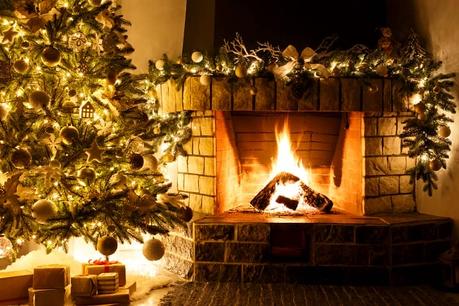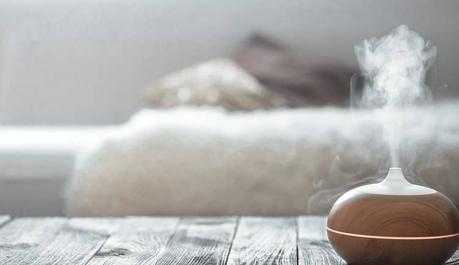We’ve explored the rules on keeping your Christmas tree alive before, but the excitement of Christmas is building and searches for ‘when to put the Christmas tree up’ have soared by 170% in the last 30 days; with some impatient homeowners putting theirs up already.
For those who like to get in the festive spirit a little earlier, we’ve taken a look at the three common mistakes made when looking after the Christmas tree.
To help homeowners keep the festive spirit alive for longer and avoid the Christmas tree drying up before Santa arrives, we have teamed up with horticulturist and Christmas tree expert Deemer Cass from Fantastic Gardeners, and Petar Ivanov of Fantastic Services, to reveal the dos and don’ts when it comes to keeping the Christmas tree alive for longer.
1- Avoid placing the Christmas tree near heat sources

Although Christmas trees look great when positioned near a cosy fire, placing it near a blazing heat source like this is a big mistake and will result in the tree drying out, looking wilted and shedding its needles all before the big day has begun.
The Christmas tree should take center stage but always avoid positioning near a heat source like radiators and fireplaces.
For a home with underfloor heating, try and turn it off in the area with your tree.
If you can’t avoid a warm place, make sure the stand or box is constantly topped up with water as a Christmas tree uses up to two litres of water a day.
Deemer says: “Regarding the temperature of the water, like most other plants, Christmas trees prefer it cold and there’s no such thing as overwatering unless you fill the stand up every hour.”
2 – Position in the corner
Figuring out the best place for the Christmas tree can be tricky especially with a smaller space.
The best spot is often in the corner of the room if space is limited, that way it’s tucked out the way and isn’t at risk of being knocked over.
Deemer commented: “If you’ve opted for a pot grown Christmas tree, place in a cool corner of your home that gets lots of natural sunlight.
“Make sure the tree is away from any heat sources too. Another key tip to note with potted Christmas trees is that you mustn’t keep indoors for more than 12 days at a time as it will slowly start dying. Move your tree outside every 10-12 days for around 24-30 hours.”
3 – A humid room

As well as the position of the Christmas tree, many of us forget about the conditions the tree needs to survive.
The home’s ideal wintertime humidity is between 45% – 50% and is also the perfect moisture level that your Christmas tree requires.
If the air is too dry, it will cause the tree to wither, in which case, use a humidifier to add moisture in the air and help your Christmas tree stay alive and fresh until the end of the holiday season.
The best Christmas trees to put up early

For those eager to get into the festive spirit early, Petar Ivanov from Fantastic Services reveals that before picking your Christmas tree you should consider the tree type as some may start to dry up and drop pines faster than others.
Petar says: “You can expect a Christmas tree to last around 3 to 4 weeks or even longer in some cases. The key is to start with a fresh tree and maintain its hydration throughout its time indoors.
“With proper care, it can last up to 5 weeks or more. If you’re wanting to decorate early, I would recommend opting for a Fraser Fir or Douglas Fir as these are known for holding their needles better than other varieties like Scotch Pine.
“When picking out your tree always inspect before purchase and choose one with vibrant, flexible needles that are firmly attached to the branches as a healthy tree at the start is more likely to last longer.
“Look for one that has the least amount of brown needles and is displayed in a shady location. It’s generally recommended to avoid picking ones from sunny display areas.”
Key considerations for prolonging the life of your tree
Below are Petar’s top tips to follow when it comes to purchasing and installing your Christmas tree and how to prolong its lifespan.
Selecting the tree species
Different species have varying levels of needle retention. For example, Fraser Fir and Douglas Fir are known for holding their needles better than other varieties, such as Scotch Pine, which may shed its needles sooner.
The freshness of the tree you buy
The freshness of the tree when you buy it is also a crucial factor.
It’s recommended to either choose a tree that has been recently harvested or cut your own for optimal freshness.
Besides that, it’s best if you don’t wait too long and buy your Christmas tree during the first week of December at the latest; to make sure you won’t be left choosing between dried-up and brittle ones.
How healthy the tree is
Inspect the tree before purchase and choose one with vibrant, flexible needles that are firmly attached to the branches; as a healthy tree at the start is more likely to last longer.
Look for one that has the least amount of brown needles and is displayed in a shady location. It’s generally recommended to avoid picking ones from sunny display areas.
How & when to water your tree
As with any plant, adequate and consistent watering is essential for prolonging a tree’s life.
Proper hydration will help maintain needle moisture and the overall freshness of your Christmas tree.
Immediately after bringing the tree home, cut about 2.5 centimetres off the base to help it absorb water better.
Keep in mind that the first few days are crucial for water absorption. Make sure to inspect the water levels of your tree daily and replenish it when it’s needed, because dry Christmas trees have actually been reported to be a huge fire hazard.
Consider the environmental conditions
Outdoor conditions, such as wind and weather, during transportation and display, can also impact a Christmas tree’s vitality.
To prevent this, shield the tree from harsh weather conditions during transport and avoid prolonged exposure to extreme temperatures.
Proper installation
Install your Christmas tree in a sturdy stand that can hold plenty of water. A secure and well-watered base is crucial for its health.
Frequently asked questions

What is the best room temperature for a Christmas tree?
The best room temperature for a real fir Christmas tree ranges anywhere from 16 to 18 degrees.
In addition to the optimal room temperature created by home radiators or alternate heating devices, there’s a number of other factors to consider that can help you maintain a healthy Christmas tree for longer.
For further information, consult our dedicated blog – Radiators & Christmas Trees: What Are The Rules?
Share View FAQ Page bCan you put your Christmas tree near a radiator?
It is advisable to avoid putting your Christmas tree near a radiator, or any other obvious heat source within the room.
By situating a Christmas tree close to heating devices such as designer radiators or heated towel rails, and alternate heat sources like fireplaces, the chances increase of the tree quickly drying out and drooping.
For more information on the do’s and don’ts of Christmas trees as it relates to your home heating, take a look at our blog – Radiators and Christmas Trees: What Are The Rules?
Share View FAQ Page bCan underfloor heating affect a real Christmas tree?
Underfloor heating can affect a real Christmas tree, in the sense that it will need to be watered more often than a tree not situated directly by a heating source.
Typically, a fir Christmas tree should be watered with a minimum of 500ml of water per day. However, bigger trees will require more, and it is recommended that those standing 6 feet tall or higher are subjected to 4 or 5 litres daily.
Essentially, real Christmas trees located in a space with underfloor heating will have to take in one or two more litres of water per day than they would in a room without, to prevent needles from dropping out quickly.
To find out more, explore our blog – Radiators and Christmas Trees: What Are The Rules?
Share View FAQ Page bWhat happens if a real Christmas tree is exposed to too much heat?
Real Christmas trees are susceptible to needles dropping out quickly, and the tree generally drooping, when exposed to too much heat.
For these reasons, it is recommended that real fir trees aren’t positioned nearby the likes of home radiators and heated towel rails, as well as alternate heat sources such as fireplaces.
In situations where this is unavoidable, such as rooms with underfloor heating, real Christmas trees should be watered more regularly with a greater volume of water on a daily basis.
To find out more, browse our dedicated blog – Radiators and Christmas Trees: What Are The Rules?
Share View FAQ Page
